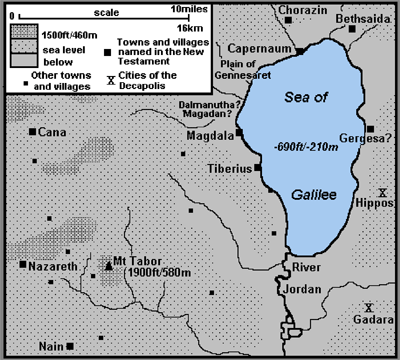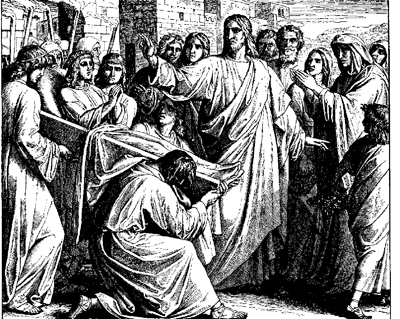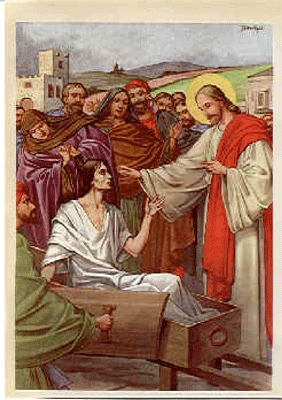
Christmas
Easter
Pentcoest
All Saints
Christ The King
Confirmation
Palm/Passion
Reformation
Stewardship
Books of the Bible
Lenten Series
Christmas Dramas
Videos
Series A - Matthew
Series B - Mark
Series C - Luke
Series D - Other
To contact
Edward F. Markquart
info@sfs.com

Series C PENTECOST 2C Luke 7:11-17 The following Bible study is from a larger course entitled, THE LIFE OF CHRIST: A Study in the Four Gospels. This 54 week course for the laity will be available for congregations in 2007. Basic text for the course: SYNOPSIS OF THE FOUR GOSPELS, Kurt Aland, English Edition, P. 75. #86. THE WIDOW’S SON AT NAIN It was believed that when the Messiah came, “the blind would receive their sight, the lame would walk, lepers would be cleansed, the deaf would hear, the dead would be raised up, and the poor would have good news preached to them.” (Matthew 11:2-6; Luke 7:18-23). This was a fulfillment of an Old Testament prophecy from Isaiah 29:18 (the deaf shall hear; the blind shall see) and Isaiah 35:5, 8 (eyes of the blind opened, the ears of the deaf unstopped, the lame man shall leap like a rabbit, the tongue of a dumb man shall leap for joy.” There are three “raising from the dead” stories in the Gospels where Jesus raised a person from the dead:
These stories illustrate that Jesus had and has the power to raise people from the dead. We, too, are promised that we shall be raised from the dead someday. This story is uniquely Luke. No other gospels record this story. Luke inserts it here. Find the city of Nain on the following map. Nain is southwest of the Sea of Galilee. It is located near Nazareth. We remember that Jesus grew up in the city of Nazareth. We recall that the first sign in the Gospel of John was the turning of the water into wine in the city of Cana (not on the map below). The second sign in the Gospel of John was the raising of the widow’s dead son in the city of Nain. Also, locate Bethsaida because this was the village where he healed Peter’s mother-in-law of her fever. Locate Capernaum, Jesus’ home town. Locate Gadara which was southeast of the Sea of Galilee where Jesus healed a man whith “legions of demons.” Locate “X,” the Decapolis, which was the area of ten Greek cities. Gadara was part of the area known as The Decapolis.
-Soon afterwards he went to a town called Nain, and his disciples and a large crowd went with him. Highlight the words, “disciples,” and the words, “great crowd.” There is always a distinction between the disciples of Jesus and the great crowds who are usually fair weather Christians, who want proof, signs, miracles, food, bread, sight, healings, in order for them to believe. True faith in Christ happens before the miracle and not as a result of the miracle or sign. -As he approached the gate of the town, a man who had died was being carried out. -He was his mother's only son, and she was a widow; and with her was a large crowd from the town. “The only son of his mother.” Highlight. The young man was her Social Security, her economic security, the heir of the family inheritance. “She was a widow.” Highlight. This woman had suffered two enormous losses: first her husband and then her son. She truly had been injured in life with two severe emotional blows. -When the Lord saw her, “And when the Lord saw her.” Highlight. Jesus is typically referred to as Lord. In the Old Testament, God was Lord. In the New Testament, Jesus is also Lord. In the Roman world of the political Caesars, Caesar was Lord. The title, Lord, is what Jesus was commonly addressed, and we still address our prayers to our Lord Jesus Christ. When we say “Lord” to Jesus, we are also claiming him to be the Lord of the Old Testament and the creator of the heavens and the earth. -He had compassion for her and said to her, This line is crucial. It says that Jesus was compassionate towards human suffering and that our God is also compassionate towards us in our suffering. God is not indifferent, calloused, or removed in a deistic indifference to our situations in life. -"Do not weep." Often, we hear from Jesus and the angels, “Do not weep.” In the midst of our normal tears, we hear the invitation that our grief will come to an end and that God will heal of hearts of their inner pain. -Then he came forward and touched the bier, and the bearers stood still. Sometimes, in our tendency to project modern thoughts into Biblical images, we see a wooden or metal coffin with pall bearers standing on either side. We simply need to remember that the burial procedures of the first century Palestine did not bury people in wooden or metal boxes. In all probability, this was a rope or hemp sling, like a hammock, and people were carrying the body in that hemp sling. -And he said, "Young man, I say to you, rise!" Jesus speaks to the young man who is dead and commands him to wake up from death and live. At the end of time and history, God will command us to sit up, to wake up, to rise from the dead as well. -The dead man sat up and began to speak, and Jesus gave him to his mother. The Greek word, behind the phrase, “sat up,” is the same Greek word in Luke 7:10 where Jesus found the slave “well.” “Sat up” and “well” are the same Greek word. “Jesus gave him to his mother.” Highlight. If any woman needed her son, this woman needed her son. Jesus knew that, and gave the woman her son back alive. -Fear seized all of them; and they glorified God, saying, Fear and awe seized the people when they experienced this miracle and they responded with praising and glorifying God. The same is true for us. When we experience a miraculous deliverance from evil in our lives, we too are overwhelmed with awe and gratitude and often praise God for the benefits that God has freely showed upon us. -"A great prophet has risen among us!" and "God has looked favorably on his people!" In the Old Testament, in II Kings 4:18-27, the greatest prophet of the Old Testament, Elijah, raised a widow’s son…at Nain. The story of Elijah’s miracle must have been imbedded in the people of Nain, and they compared Jesus to this great prophet. “God has visited his people.” Highlight. That feel often is found in us when we have experienced a miracle of God’s presence and deliverance: we have been visited by the gracious power and presence of God. -This word about him spread throughout Judea and all the surrounding country. In other words, people were telling their story about Jesus and his power to give to life and to raise a person from the dead. Some scholars try to explain the miracles of Jesus in natural terms e.g. the young man was in a deep trance and Jesus called him out of the trance. Sometime during our lives, most of us have attempted to rationally explain the miracles. When we do that, we are also aware that the miracle of God raising Jesus from the dead is beyond our rational attempts to explain it. Similarly, the miracle of God raising us from the dead at the end of time is also beyond our rational explanations. Eventually, we fall back into the position of: “I believe it” or “I don’t believe it.” There are no proofs, no verifications, no signs, no wonders but simply faith that God/Christ work miracles in us and around us. The greatest miracle at all is the miracle of belief. Painting and Imagination:
http://www.biblia.com/jesusm/nain.htm
|


